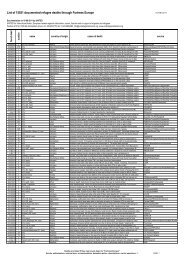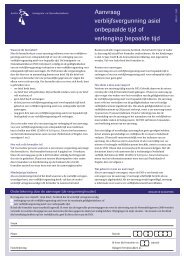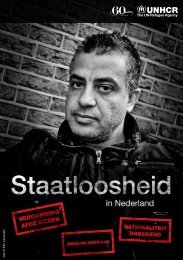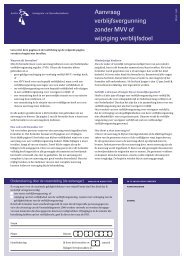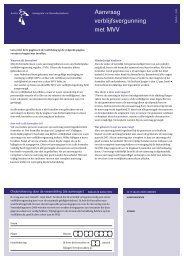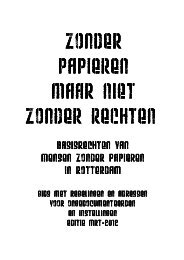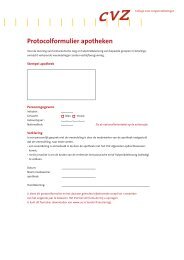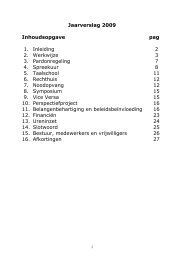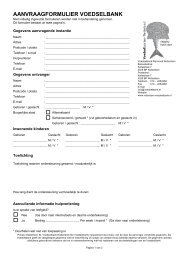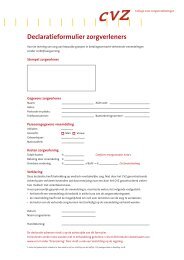Handboek voor begeleiders van vluchtelingen en ... - Stichting ROS
Handboek voor begeleiders van vluchtelingen en ... - Stichting ROS
Handboek voor begeleiders van vluchtelingen en ... - Stichting ROS
You also want an ePaper? Increase the reach of your titles
YUMPU automatically turns print PDFs into web optimized ePapers that Google loves.
• Conv<strong>en</strong>tion against Torture and Other Cruel, Inhuman or Degrading Treatm<strong>en</strong>t<br />
of Punishm<strong>en</strong>t (CAT): Under Article 3 of CAT, State Parties are prohibited from<br />
returning or extraditing persons to another State where they may face torture. Article<br />
16 requires states to prev<strong>en</strong>t acts of cruel, inhuman or degrading treatm<strong>en</strong>t or<br />
punishm<strong>en</strong>t by or at the instigation of or with the cons<strong>en</strong>t or acquiesc<strong>en</strong>ce of public<br />
officials or other persons in an official capacity. CAT also provides an individual<br />
complaint mechanism for persons to file against State Parties who claim to be victims<br />
of a violation of the Conv<strong>en</strong>tion.<br />
• Conv<strong>en</strong>tion on the Rights of the Child (CRC): Article 3 of the CRC establishes the<br />
standard of best interest of the child in all actions concerning childr<strong>en</strong>, whether tak<strong>en</strong><br />
by public or private institutions. Article 9 requires State Parties to <strong>en</strong>sure that<br />
childr<strong>en</strong> are not separated from their par<strong>en</strong>ts against their will with some exceptions.<br />
Article 22 requires that State Parties take all appropriate measures to make sure that a<br />
refugee child or one who is seeking refugee status, whether accompanied or<br />
unaccompanied, be giv<strong>en</strong> appropriate protection and humanitarian assistance. Article<br />
37 prohibits torture or other cruel, inhuman or degrading treatm<strong>en</strong>t or punishm<strong>en</strong>t<br />
against childr<strong>en</strong> and states that childr<strong>en</strong> should not be deprived of their liberty<br />
unlawfully or arbitrarily. Det<strong>en</strong>tion should only be used as a last measure and for the<br />
shortest time possible.<br />
• Conv<strong>en</strong>tion on the Protection of the Rights of All Migrant Workers and<br />
Members of Their Families (Migrant Workers Conv<strong>en</strong>tion): Several provisions<br />
in the Migrant Workers Conv<strong>en</strong>tion address det<strong>en</strong>tion. Article 16 provides that<br />
migrants should not be subjected either individually or collectively to arbitrary arrest<br />
or det<strong>en</strong>tion. Article 17 states that wh<strong>en</strong> detained, migrants must be held in<br />
conditions of dignity and should be held separate from persons convicted of crimes or<br />
awaiting trial. Article 23 provides that migrants in det<strong>en</strong>tion have a right to be<br />
advised of their right to contact their consulate and efforts should be made by the<br />
detaining authorities to facilitate such access wh<strong>en</strong> requested. It should be noted that<br />
the Migrant Workers Conv<strong>en</strong>tion applies to both docum<strong>en</strong>ted and undocum<strong>en</strong>ted<br />
migrants.<br />
• Standard Minimum Rules for the Treatm<strong>en</strong>t of Prisoners: These rules were<br />
adopted by the First United Nations Congress on the Prev<strong>en</strong>tion of Crime and the<br />
Treatm<strong>en</strong>t of Off<strong>en</strong>ders in G<strong>en</strong>eva in 1955 and approved by the Economic and Social<br />
Council by resolutions in 1957 and again in 1977. They apply to both civil and<br />
criminal prisoners and set out what is good principle and practice in the treatm<strong>en</strong>t of<br />
prisoners and the managem<strong>en</strong>t of institutions which detain and house prisoners. The<br />
Rules cover issues such as: separation of differ<strong>en</strong>t categories or prisoners; type of<br />
accommodation; personal hygi<strong>en</strong>e; clothing and bedding; exercise and sport; medical<br />
services; discipline and punishm<strong>en</strong>t; instrum<strong>en</strong>ts of restraint; information to and<br />
complaints by prisoners; contact with the outside world; books; religion; ret<strong>en</strong>tion of<br />
prisoners’ property; notification of death, illness, transfer, etc.; removal of prisoners;<br />
institutional personnel; and inspection of prisons.<br />
• Code of Conduct for Law Enforcem<strong>en</strong>t Officials: The code, adopted by the UN<br />
G<strong>en</strong>eral Assembly in 1979, applies to all law <strong>en</strong>forcem<strong>en</strong>t personnel defined as: all<br />
officers of the law, whether appointed or elected, who exercise police powers,<br />
65




